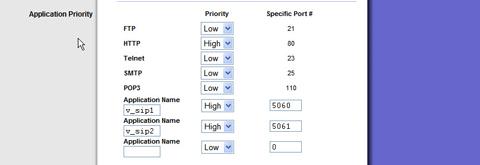VoIP Application QoS
Application QoS-linksys routers
Application Priority QoS settings are unfortunately very limited
in many Linksys routers.
The available application QoS options are just but a few and are
limited to an exact port, rather than a range of ports, which
would be more advantageous for most VoIP connections.
Typically, VoIP providers
 use larger carriers to carry their voice traffic and these
carriers (like Level3) choose a UDP port from a wide range of
ports to carry the voice data. The VoIP provider has to be
ready to accept that particular port for the voice protocol.
For you the user to prioritize the voice traffic by using the
application port you would need to give a High QoS priority for
RTP, which would require that range to be set in the router.
use larger carriers to carry their voice traffic and these
carriers (like Level3) choose a UDP port from a wide range of
ports to carry the voice data. The VoIP provider has to be
ready to accept that particular port for the voice protocol.
For you the user to prioritize the voice traffic by using the
application port you would need to give a High QoS priority for
RTP, which would require that range to be set in the router.
Information on Application QoS
Application Priority QoS
Application based QoS allows you to have control over a specific application used on the your network. By assigning a Low or High priority to a particular port you can control data traffic using that port. Since most applications or services are port specific, the priority then controls that application. Unfortunately, VoIP service typically uses a wide range of RTP ports to carry the voice traffic which many home/small office routers are incapable of prioritizing as a range. Better more sophisticated routers have this option.
Use caution when configuring QoS to prevent redundancy. If, for example, you specified your VoIP ATA under Device Priority to have High Priority, there is really no need to do anything here which would be beneficial.
Looking at the typical Linksys router you will find several pre-configured settings built-in for a few well known and widely used services that utilize established ports, like FTP, HTTP, POP3 and SMTP. There are allowable configurations to customize up to three different applications by entering an Application Name and the individual Specific Port number for that software application. We recommend keeping any competing applications at Low (applications that may slow down voice traffic) and set a High priority for SIP signaling. Setting SIP ports for priority will do nothing for voice quality, it only allows the signaling protocol to pass quicker, but this could be an advantage in in a hosted VoIP environment with several phones. The typical ports for SIP are 5060 for line 1 and 5061 for line 2 on your VoIP account, but your provider may use other ports.

In the example above we picked the two traditional SIP signaling ports for High Priority and also HTTP for web surfing. Other applications like POP3 and SMTP, typical email protocols were left at Low so they would less likely inhibit the VoIP data traffic.
Some ports that VoIP may require.
Typical ports that "may" be required for a VoIP connection
(your VoIP provider may vary) are the SIP signaling ports of 5060
and 5061 (and possibly up to 5080) UDP, plus possible STUN ports of
3478/79. Plus the RTP
(Real-time Transport Protocol) ports, which carry the actual
data for the voice conversation. RTP ports are typically
negotiated between the VoIP proxy server and the user via either the
ATA device or soft phone. These RTP ports will usually be in a
range between 10,000 to 20,000 or include a specific range within
that range. Your VoIP provider should be able to tell you what
range they use.
Using Advanced firmware on some Linksys Routers
There are several free firmwares that can replace existing factory installed operating firmware on some models of Linksys routers (as well as other well known manufacturers of small routers). One is Tomato which has gotten good reviews and can be flashed onto Linksys WRT54G/GL/GS routers. It has more advanced features, an easy to use GUI, and has configurations for many more advanced QOS and access restriction features.



